The Institute of the Arts and Sciences at UC Santa Cruz (IAS) and San José Museum of Art (SJMA) are pleased to present Seeing through Stone, a multi-sited exhibition bringing together works by international artists whose works engage a history of struggle against prisons and their harms. This will be the largest exhibition to date of Visualizing Abolition—an ongoing scholarship initiative exploring art, prisons, and justice organized by the IAS.
Seeing through Stone will present over 80 artists and collectives as well as 16 new commissions at 3 venues, the IAS (opening on April 12), Santa Cruz Barrios Unidos (opening on April 18), and SJMA in San José (opening on April 26). Seeing through Stone will be on view at all three venues through January 5, 2025.
“There have been notable recent exhibitions showing the harms caused by incarceration. Seeing through Stone continues this work by focusing on how artistic practice can model alternatives to systems based on punishment. Artists can show us different ways of seeing and moving through the world, helping imagine new societal structures, not based on punishment but on care,” stated Lauren Schell Dickens, chief curator at SJMA.
Seeing through Stone is titled after Etheridge Knight’s writing in Poems in Prison, composed while the poet was incarcerated in Indiana State Prison. The artists and collaborators featured in the exhibition, including currently and formerly incarcerated artists alongside those without lived experience, are those who see a world otherwise.
“In the past, it was rarely considered that artists would have something to say about the prison system,” noted Gina Dent, professor of Feminist Studies, History of Consciousness, and Legal Studies at UC Santa Cruz. “Historically, only criminologists, sociologists, and legal professionals were permitted to contribute to the discourse. But holistically, we really need people from every discipline and walk of life to be a part of the thinking about how to enact social change.”
Past exhibitions and programs for Visualizing Abolition primarily focused on prisons and abolition on the national level, with Seeing through Stone widening the scope to point at carceral conditions internationally. The 16 newly commissioned projects and other works emerge from different sociopolitical contexts around the globe, from Brazil, to the Philippines, Guantanamo, Bangladesh, the US, and elsewhere. With video, painting, sculpture, installation, sound, and performance, the exhibition charts what scholars and activists call an expanding “constellation of abolition” —the ongoing organizing, activism, dreaming, and worldmaking taking place across the globe.
“According to a 2023 study by Penal Reform International, over 11.5 million people are estimated to be imprisoned worldwide,” stated Rachel Nelson, director and chief curator of IAS. “Artists both inside and outside of prisons throughout the world recognize that cultural shifts are necessary to change this global dynamic."
SJMA began collaborating with IAS on exhibitions for Visualizing Abolition in 2020 with the co-presented exhibition Barring Freedom, which tackled complex themes of policing, detention, and imprisonment that make up the prison industrial complex in the United States. Subsequent new commissions and solo exhibitions for Visualizing Abolition at SJMA also addressed issues in the American carceral landscape and history including Sky Hopinka: Seeing and Seen in 2022; Sadie Barnette: Family Business in 2023, and Forensic Architecture’s project If toxic air is a monument to slavery, how do we take it down? in January 2024.
“UC Santa Cruz has a long history of research, teaching, and activism in public service and social justice. We are proud to partner with them to engage students and the public with new ways of thinking and collaborative problem-solving to improve the quality of life for everyone, from our regional community to the entire world.” said S. Sayre Batton, Oshman Executive Director at SJMA.
In conjunction with the exhibition, SJMA and IAS plan to co-host a series of public programs and events that further explore the interdisciplinary ties between art and prison abolition. Seeing through Stone will also be accompanied by a catalog to be released in late 2024.
Artist list: Daniel Alas, Frank Alejandrez, Moath Al-Alwi, Ghaleb Al-Bihani, Al-Haq’s Forensic Architecture Investigation Unit, Djamel Ameziane, Juan Arredondo, Robert Barber, Sadie Barnette, Albert Bell, Rebecca Belmore, Dawin Billingsley, Imani Jacqueline Brown, Mark Cadiz, Ben Chandler, Christopher Christensen, Sharon Daniel, Ronald Davenport, Cian Dayrit, Joseph Dole, Caleb Duarte with Santa Cruz Barrios Unidos, Explode! (Cláudio Bueno, João Simões, and collaborators), Darrell Fair, Flávia Ferreira dos Santos, Frente 3 de fevereiro, Charles Gaines, Guillermo Galindo, Aimee Gana, Maria Gaspar, Gabriela Golder, Patricia Gómez and Mª Jesús González Fernández, Roquelina Gomes de Souza, Chantell Gosztyla, Shilpa Gupta, Jessica Macie Hann, Sky Hopinka, Ashley Hunt, Jonathan Huynh, Jeffrey Isom, Donnie Wayne Ivy, Steffani Jemison, Micheal Jones, Alejandro Jotelo, Sofia Karim, Bouchra Khalili, Robert King, Juan Luna, Jose-Luis, Eric Maciel, Bryan Matheson, Nathaniel McCray, Jessie Milo, Carlos Motta, Mulheres Possíveis, Gabriela Mureb, Hương Ngô, Brad Odell, O grupo inteiro (Carol Tonetti, Cláudio Bueno, Ligia Nobre, Vitor Cesar with Vanessa Soares, and Lorran Dias), John Ortega, Robert Ortiz, Samora Pinderhughes, Khalid Qasim, Mesro Dhu Rafa'a, George Red, Sherrill Roland, Vitória Daiane Emídio dos Santos, Ronnie Shelton, Harold Smith, Orlando Smith, Sable Elyse Smith, Mark Anthony Stanley, Paul Stauffer, Ronald Steele, Doris Sterling, jackie sumell, Tea Project (Amber Ginsburg & Aaron Hughes), Timesfive (Moira Murdock & jackie sumell), Luis Trevino, Ernesto Valle, Hajra Waheed, Rachel Wallis with Mariame Kaba, Levester Williams, Lovelyocean Williams, Timothy James Young, among others.
PROGRAMMING
Opening Celebration
Institute of the Arts and Sciences
Friday, April 12, 6–8pm
Free
Zombaria Practices: exercises with the body and radical imagination with Vanessa Soares (O groupo inteiro)
Institute of the Arts and Sciences
Saturday, April 13, 2:30–4pm
Opening Celebration
Santa Cruz Barrios Unidos
Friday, April 19, 6–8pm
Free
Opening Celebration
San José Museum of Art
Friday, April 26, 2024, 6–9pm
Free
Abolitionist’s Tea Party with jackie sumell
San José Museum of Art
Saturday, April 27, 2024, 2–4pm
Free
Creative Minds: Sofia Karim
San José Museum of Art
Thursday, May 30, 2024, 6:30pm
Free with Museum admission.
Make Music Day: Maria Gaspar with James Gordon William, and Guillermo Galindo
San José Museum of Art
Friday, June 21, 2024, 4pm
Free
Seeing through Stone publication launch and performance with Gabriela Golder
San José Museum of Art
Friday, November 15, 2024, 6pm
Programs are subject to change. For up-to-date information, please go to sjmusart.org/calendar.
Seeing through Stone is co-curated by Gina Dent, Lauren Schell Dickens, and Rachel Nelson. Gina Dent is associate professor of Feminist Studies, History of Consciousness, and Legal Studies at UC Santa Cruz. Lauren Schell Dickens is the chief curator at SJMA. Rachel Nelson is director and chief curator at IAS.
SUPPORT
Seeing through Stone is made possible by the Mellon Foundation and the SJMA Exhibitions Fund, with lead support from the Myra Reinhard Family Foundation.
Operations and programs at the San José Museum of Art are made possible by principal support from SJMA’s Board of Trustees, a Cultural Affairs Grant from the City of San José, and the Lipman Family Foundation; by lead support from the Adobe Foundation, Toby and Barry Fernald, Brook Hartzell and Tad Freese, the Richard A. Karp Charitable Foundation, Tammy and Tom Kiely, Kimberly and Patrick Lin, Sally Lucas, Yvonne and Mike Nevens, the David and Lucile Packard Foundation, the Skyline Foundation, and the SJMA Director's Council and Council of 100; and with significant endowment support from the William Randolph Hearst Foundation and the San José Museum of Art Endowment Fund established by the Knight Foundation at the Silicon Valley Community Foundation.
INSTITUTE OF THE ARTS AND SCIENCES, UC SANTA CRUZ
As the keystone public galleries at UC Santa Cruz, the Institute of the Arts and Sciences presents a unique vision for the arts at the forefront of social transformation. Drawing on the resources of a leading research university, the world-class exhibitions at the Institute engage the most critical issues of our time, catalyzing meaningful encounters with the arts and ideas.
The Institute Galleries are located at 100 Panetta Avenue, on the westside of Santa Cruz and are open Tuesday-Sunday, 12 pm-5 pm. Admission is free to the public. More information at ias.ucsc.edu/
SAN JOSE MUSEUM OF ART
The San José Museum of Art (SJMA) is a contemporary art museum dedicated to inclusivity, new thinking, and visionary ideas. Founded in 1969 by artists and community leaders, its dynamic exhibitions, collection, and programs resonate with defining characteristics of San José and the Silicon Valley—from its rich diversity to its hallmark innovative ethos. The Museum offers lifelong learning for school children and their educators, multigenerational families, creative adults, university students and faculty, and community groups. SJMA is committed to being a borderless museum, essential to creative life throughout the diverse communities of San José and beyond.
SJMA is located at 110 South Market Street in downtown San José, California. The Museum is open Thursday 4–9pm; Friday 11am–9pm; and Saturday–Sunday 11am–6pm. Admission is $15 for adults, $12 for seniors, and free to members, college students, youth and children ages 17 and under, and school teachers (with valid ID). Admission is free from 6–9pm on the first Friday of every month. For up-to-date information, call 408.271.6840 or visit SanJoseMuseumofArt.org.

